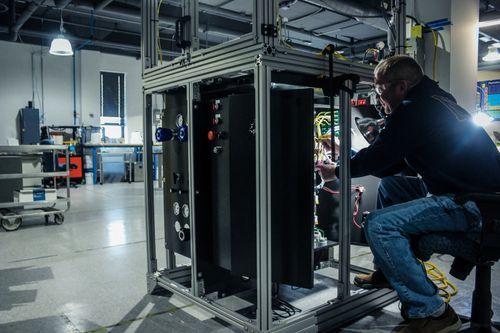New Energy Blue, the clean-energy developer of lowest-carbon biofuel and biochemicals from crop residues, today advances its Decarbonizing America agenda by forming New Energy Chemicals.
In phase one, the new biochemical subsidiary will produce American-sourced and American-made bio-based ethylene to enable Dow’s production of low carbon plastics used in everyday life; in phase two, it will expand operations at its Port Lavaca, Texas, facility to produce sustainable aviation fuel (SAF), according to a news release.
“New Energy Chemicals opens multiple pathways to our exponential growth in biobased fuels and chemicals,” says Albury Fleitas, President of New Energy Blue. “We’re particularly excited by our new end-to-end alternative to Brazilian ethanol for making SAF, which will begin in the American Midwest by refining agricultural waste.”
“Flexibility is baked into the process design and business operations of our biomass refineries,” adds CEO Thomas Corle. “We’re not locked into a single product, single market, or single feedstock. New Energy Chemicals gives us 360-degree downstream options for achieving liftoff of an American bioenergy revolution. We can pivot to mitigate market risk, seize growth opportunity, and hit lowest-carbon targets consistently.”
In late 2025, the New Energy Freedom biomass refinery in Mason City, Iowa, will begin converting local corn stalks into 16-20 million gallons a year of highly decarbonized (HD) cellulosic ethanol and 120,000 tons of clean HD lignin. Lignin has high value as a fossil substitute in markets like paving American roads and decarbonizing steel production.
Some of Freedom’s ethanol is destined for California and Oregon auto fuel markets; by meeting their strict low-carbon standards, it will reduce greenhouse gas emissions by over 100% per gallon of gasoline displaced. Millions of HD gallons will also head to Texas, where New Energy Chemicals will convert it into bio-based ethylene, transported via pipeline to Dow’s U.S. Gulf Coast operations for production of renewable plastics across fast-growing end markets.
Dow’s use of bio-based feedstocks from New Energy Blue is expected to be certified by ISCC Plus, an international sustainability certification program with a focus on traceability of raw materials within the supply chain. While Dow intends to mix agriculture-based ethylene into its existing manufacturing process, ISCC Plus’s chain of custody certification would allow Dow’s customers to account for bio-based materials in their supply chains.
Albury Fleitas reports that “strategic and institutional investors are actively involved in our Freedom and Chemicals projects and upcoming expansions. With engineering design completed and major permits secured, we’ve reached the final investment decision (FID) stage. By partnering with an international bank and securing USDA loan guarantees for both project sites, we anticipate ground-breaking this year.”
New Energy Blue has ambitious plans to expand its biomass refineries across America’s 140-million-acre corn belt and wheat basin, harvesting excess straws and stalks to produce billions of gallons of highly decarbonized ethanol. Shorter-term, a six-year strategy calls for attracting $3.5 billion from capital markets to build four new refineries at twice the size of Freedom and provide abundant feedstock to New Energy Chemicals. Taken together, the five refineries are designed to keep over 1,000,000 tons of CO2 out of the atmosphere annually.
Beyond meeting its growing commitments to Dow, New Energy Chemicals’ phase-two expansion can capitalize on both domestic and international demand for SAF since the Port Lavaca site has barge access to deep water shipping.
Substantial European demand by 2030 is expected from the ReFuelEU Aviation initiative, which aims to mandate a SAF blending requirement at EU airports. In addition to ramping up its biomass refinery build-out, New Energy Blue plans to license its platform globally to accelerate the production of low-carbon, plant-based feedstock for HD auto fuel, SAF, and other biochemicals.
According to the U.S. Sustainable Aviation Fuel Grand Challenge, the American SAF goal is 3 billion gallons a year by 2030, 35 billion gallons by 2050. “U.S. carbon-reducing incentives have ignited a $400 billion SAF market,” Fleitas notes. Lifecycle analysis of the company’s refinery project consistently exceeds the required 50% reduction in GHG emissions compared to ethanol made from corn grain or sugar cane. New Energy Chemicals is expected to pre-qualify for maximum decarbonizing credits, giving it an advantage in a competitive capital marketplace.
The HD ethanol-to-ethylene process employed by New Energy Chemicals is most likely compatible with conventional jet fuel methods of production, using a technology pathway similar to Brazilian ethanol-to-SAF conversion.
“Except there’s a significant gap in decarbonization scores,” says Kelly Davis, Vice President, “and that gives our future SAF a dramatic edge in getting the airlines closer to their net-zero goal for GHG emissions. It’s an extra advantage that comes from using American-sourced leftovers from the annual grain harvest.”
Because of process design flexibility, New Energy Blue biomass refineries can also convert wheat, barley, and rye straws. In arid regions where food crops can no longer grow, the company intends to restore American grasslands by planting and harvesting perennials like arundo donax and miscanthus.
“Decarbonizing America is a big ask for a big task,” Corle says. “Those 140 million acres of U.S. grain provide enough stalks and straws and grasses to feed 500 refineries and produce 20 billion gallons of exceptionally low-carbon ethanol annually. That’s how you decarbonize SAF and Dow’s renewable plastic materials, how you make a dent in replacing oil refining with biomass refining.
“It starts with a biomass refinery in Mason City, Iowa and New Energy Chemicals conversion operations in Port Lavaca, Texas. But we’re already forging partnerships with governments, customers, and developers across Canada, Europe, Asia, and Africa. Inviting them to work collaboratively towards sustainable decarbonization with global impact.”






